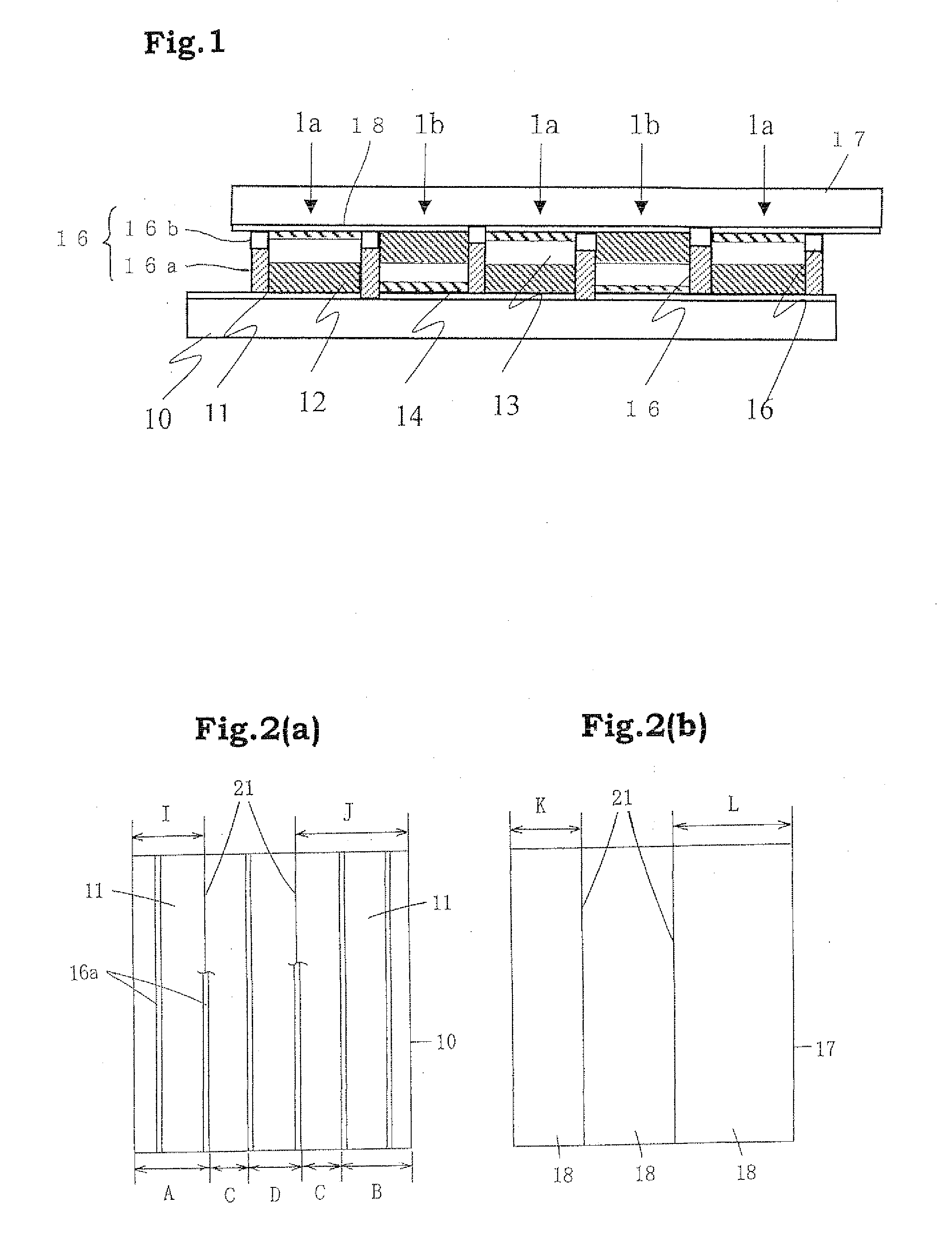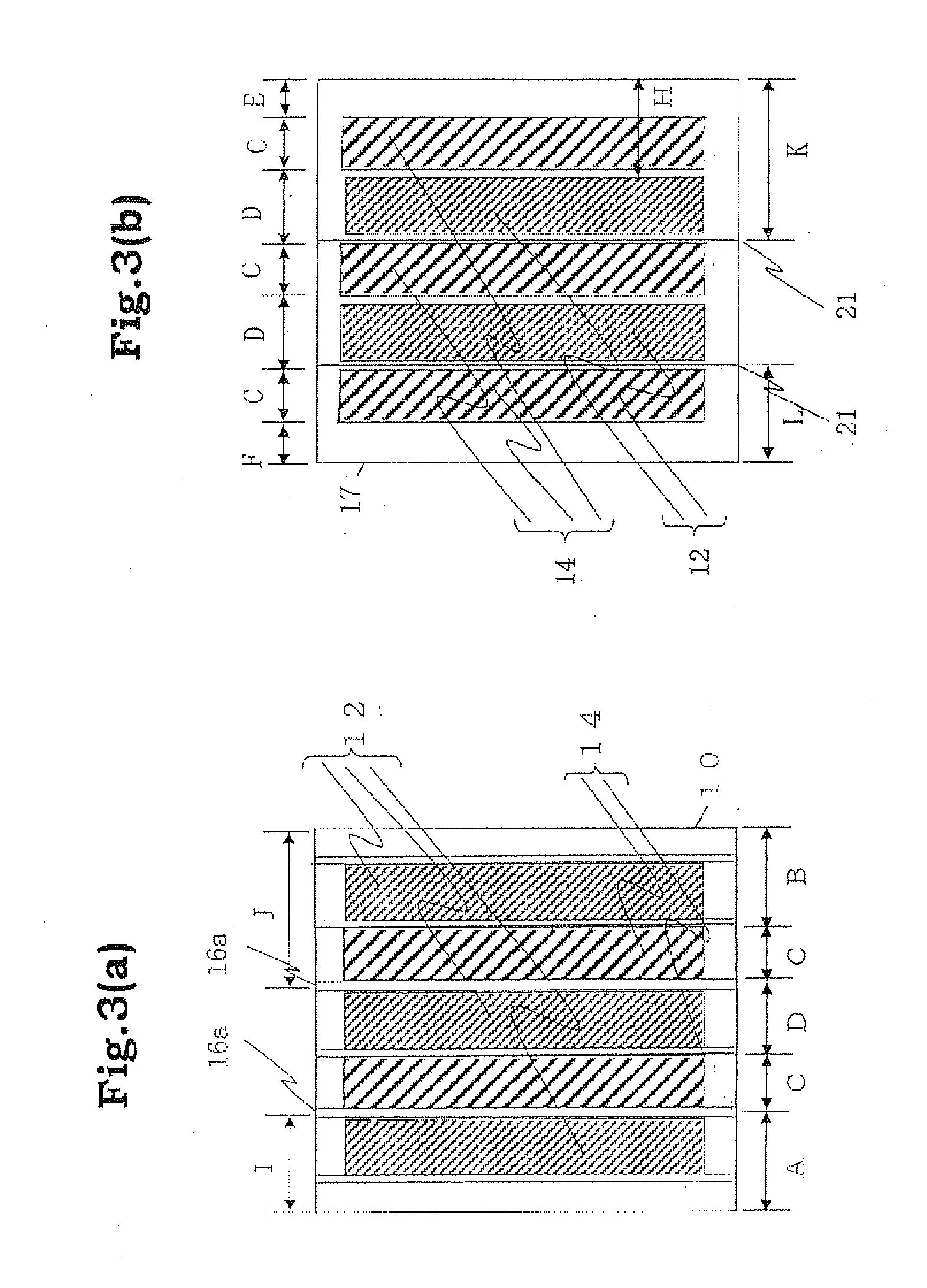Dye-sensitized solar cell module and method of manufacturing the same (as amended)
a solar cell and dye sensitization technology, applied in the direction of cell components, final product manufacturing, sustainable manufacturing/processing, etc., can solve the problems of reducing the photoelectric conversion efficiency, the difficulty of applying this solar cell to a solar cell with a large surface area such as 1 m square,
- Summary
- Abstract
- Description
- Claims
- Application Information
AI Technical Summary
Benefits of technology
Problems solved by technology
Method used
Image
Examples
embodiment 1
[0094]FIG. 1 is a sectional view showing a schematic constitution of a dye-sensitized solar cell module (W-type module) of Embodiment 1 of the present invention. In this solar cell module, a first photoelectric conversion device 1a and a second photoelectric conversion device 1b are alternately located in a state in which the first photoelectric conversion device 1a and the second photoelectric conversion device 1b are electrically connected in series between a pair of substrates 10, 17 having a plurality of conductive layers 11, 18 formed in parallel with one another on the surface of the substrates. In this embodiment, a lower substrate in FIG. 1 is taken as a light-receiving plane side, and at least the lower substrate 10 and the conductive layer 11 have a light transmitting property.
[0095]The first photoelectric conversion device 1a is formed by laminating the porous semiconductor layer 12, the electrolyte layer 13, and the catalyst layer 14 in succession from the lower substrat...
embodiment 2
[0111]FIG. 4 is a sectional view showing a schematic constitution of a dye-sensitized solar cell module (W-type module) of Embodiment 2 of the present invention. In addition, in FIG. 4, the same reference numerals and characters are given to the constituent elements similar to Embodiment 1 shown in FIG. 1.
[0112]The solar cell module of Embodiment 2 has the same structure as in Embodiment 1 except that the insulating layer of this solar cell module has a structure of three layers as distinct from Embodiment 1. Hereinafter, difference of a structure of this solar cell module from that of Embodiment 1 will be mainly described.
[0113]In Embodiment 2, the insulating layer 26 is formed by laminating the first insulating layer 26a, the second insulating layer 26b and the third insulating layer 26c. The first insulating layers 26a are formed on the conductive layer 11 and on the substrate 10 on a light-receiving plane side and the third insulating layers 26c are formed on the conductive laye...
embodiment 3
[0125]FIG. 5 is a sectional view showing a schematic constitution of a dye-sensitized solar cell module of Embodiment 3 of the present invention. In this solar cell module, a plurality of photoelectric conversion device 3a having the same constitutions are located in a state of being electrically connected in series between a pair of substrates 30, 37 having a plurality of conductive layers 31, 38 on the surface of the substrates. In this embodiment, a lower substrate in FIG. 5 is taken as a light-receiving plane side, and at least the lower substrate 30 and the conductive layer 31 have a light transmitting property. The photoelectric conversion device 3a is formed by laminating the porous semiconductor layer 32, the electrolyte layer 33, and the catalyst layer 34 in succession from the lower substrate 30, and the upper and lower conductive layers 31 and 38 are divided into two or more parts so as to be connected to only the porous semiconductor layer 32 and the catalyst layer 34, r...
PUM
 Login to View More
Login to View More Abstract
Description
Claims
Application Information
 Login to View More
Login to View More - R&D
- Intellectual Property
- Life Sciences
- Materials
- Tech Scout
- Unparalleled Data Quality
- Higher Quality Content
- 60% Fewer Hallucinations
Browse by: Latest US Patents, China's latest patents, Technical Efficacy Thesaurus, Application Domain, Technology Topic, Popular Technical Reports.
© 2025 PatSnap. All rights reserved.Legal|Privacy policy|Modern Slavery Act Transparency Statement|Sitemap|About US| Contact US: help@patsnap.com



